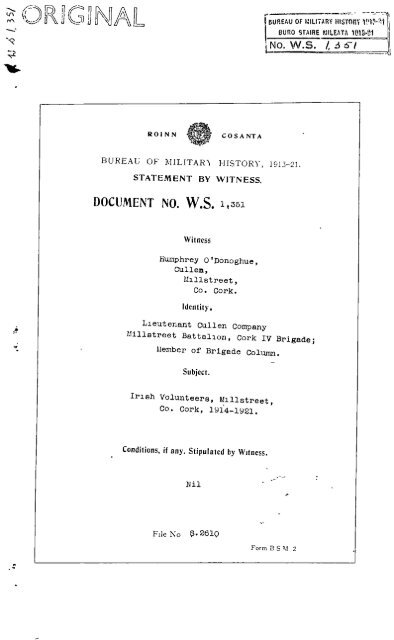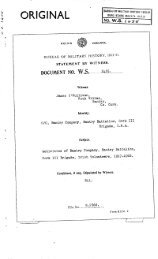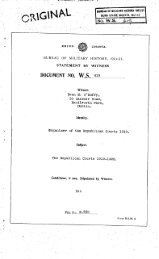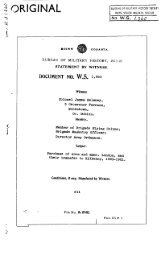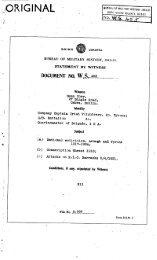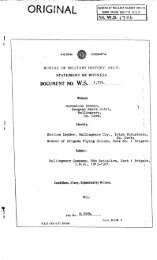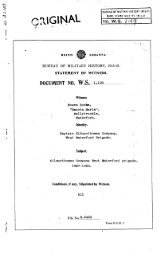Humphrey O'Donoghue - The Bureau of Military History 1913-1921
Humphrey O'Donoghue - The Bureau of Military History 1913-1921
Humphrey O'Donoghue - The Bureau of Military History 1913-1921
Create successful ePaper yourself
Turn your PDF publications into a flip-book with our unique Google optimized e-Paper software.
ROINNCOSANTABUREAU OF MILITARY HISTORY, <strong>1913</strong>-21.STATEMENT BY WITNESSDOCUMENT NO. W.S. 1,351Witness<strong>Humphrey</strong>Cullen,<strong>O'Donoghue</strong>,Millstreet,Co. Cork.Identity.Lieutenant Cullen CompanyMillstreet Battalion, Cork IV Brigade;Member <strong>of</strong> Brigade Column.Subject.IrishVolunteers, Millstreet,Co. Cork, 1914-<strong>1921</strong>.Conditions, if any. Stipulatedby Witness.NilFile No S.2610Form BSM2
STATEMENT BY HUMPHREY O'DONOGHUECullen, Millstreet, Co. Cork.I was born in November 1894, at Cullen. My parents wereteachers. I was educated at Cullen National School until Ireached the age <strong>of</strong> 15 years. I then went to work on my aunt'sfarm.I joined the Irish Volunteers in Millstreet in 1914.Padraig Pearse and Terry McSwiney were the principal speakersat an Aeriocht there on the day I joined. Others who joinedon that day were Denis O'Leary, Tim Condon, Dan T. O'Riordanand <strong>Humphrey</strong> Lynch and William Ring. <strong>The</strong>se formed the nucleus<strong>of</strong> a Volunteer unit in Cullen. <strong>The</strong> strength <strong>of</strong> the unit wasabout ten. We were drilled in the initial stages by JimmieHickey and Jerry Twomey from Millstreet. When things settleddown Denis J. O'Leary was elected O/C. Weekly parades wereheld in the fields at night and on Sunday evenings. This type<strong>of</strong> activity continued up to Easter 1916, but we did not receiveany orders in connection with Easter Week. However, when some<strong>of</strong> the Volunteers in Millstreet were arrested after the Rising,<strong>Humphrey</strong> Lynch, Denis O'Leary and I did not sleep at home forabout three months. <strong>The</strong>re was no activity in the area atEaster 1916.When the Irish Volunteers were reorganised in the summer<strong>of</strong> 1917, all he old members joined up as well as a small number<strong>of</strong> others. As 1917 advanced, the company grew in strength untilthe membership reached about 50. At this time the <strong>of</strong>ficers <strong>of</strong>the company (elected) were:- O/C. Dan T. O'Riordan; 1st Lieut.<strong>Humphrey</strong> <strong>O'Donoghue</strong> (witness); 2nd Lieut. Dan Moynihan.Although the members <strong>of</strong> our company resided in Co. Cork,our unit was attached, at the time, to Rathmore Battalion, Kerry
2.Brigade. All the other companies in the battalion were inKerry.<strong>The</strong> only type <strong>of</strong> training carried out was close orderfoot drill under our own <strong>of</strong>ficers. Training usually tookplace in the fields in the vicinity <strong>of</strong> Cullen.When the British threatened to introduce conscriptionin early 1918 there was a big influx <strong>of</strong> recruits to theVolunteers. Nearly every man <strong>of</strong> military age in the areajoined up and the strength <strong>of</strong> the company increased to about130. About this time our company was detached from RathmoreBattalion and became a unit <strong>of</strong> Millstreet Battalion, CorkBrigade. During the conscription period all shotguns notalready held by Volunteers were collected together with anyavailable ammunition; <strong>The</strong> guns were surrendered voluntarilyin every case. We now had between 30 and 40 shotguns and about400 rounds <strong>of</strong> ammunition. All who could not be armed withshotguns were provided with croppy pikes which were made inthe local forges. <strong>The</strong> ordinary charges <strong>of</strong> shot in thecartridges were replaced by buckshot. <strong>The</strong> activities inconnection with the manufacture <strong>of</strong> arms, in addition to thework <strong>of</strong> watching and reporting on the movements <strong>of</strong> the R.I.C.and other enemy forces, helped to make the work <strong>of</strong> theVolunteers more interesting and turned their minds towardsmilitary affairs in many cases for the first time. When theconscription scare had passed, a small number <strong>of</strong> membersdrifted away, but the main body continued to serve up to theTruce.When the threat <strong>of</strong> conscription had passed, activitiesbecame somewhat slack, but the approach <strong>of</strong> the General Electionin December 1918 gave the Volunteers an opportunity to work.for the political wing <strong>of</strong> the republican movement - Sinn Féin.However, there was no exceptional activity in our area as the
3.Sinn Fein candidate - Paudeen O'Keeffe - was returned unopposedWhen Cork II Brigade was formed in January 1919, ourbattalion (Millstreet) became the 7th Battalion in the newbrigade. <strong>The</strong> companies in the battalion were:- Millstreet,Rathduane, Cullen, Drishane, Dooneen, Rathcoole, Derrynagree,Kilcorney, Mushera. <strong>The</strong> <strong>of</strong>ficers <strong>of</strong> the battalion were:-O/C. Con J. Meany; Vice O/C. Denis O'Brien; Adjutant- Jerh.Crowley; Q.M.- Denis Galvin.Fermoy<strong>The</strong> <strong>of</strong>ficers <strong>of</strong> the new brigade were:- O/C. Liam Lynch;Vice O/C. Dan Hegarty, Mallow; Adjutant- Tom Barry, Glanworth;Q.M. - George Power, Fermoy.<strong>The</strong>re were seven battalions in cork II Brigade:- Fermoy,Castletownroche, Mallow, Kanturk, Charleville, Newmarket andMillstreet.<strong>The</strong> usual training went on at this time and there wasoccasionally a little target practice with .22 rifle whenammunition could be procured. About this time, the variouscompanies in the battalion occasionally assembled on Sundayevenings for combined exercises -moving across country inextended order, scouting. Units were <strong>of</strong>ten called out atnight and sent on cross country exercises.About Mid-November 1919, <strong>of</strong>ficials <strong>of</strong> the Munster andLeinster Bank in Millstreet were held up on their way toKnocknagree Fair and a large amount <strong>of</strong> money was taken fromthem. <strong>The</strong> R.I.C. when investigating the hold-up confined thequestioning to members <strong>of</strong> the I.R.A. and, as a result, everybodyoutside the I.R.A. began to suspect that they wereresponsible. When the attitude <strong>of</strong> the general public in thearea was brought to the notice <strong>of</strong> the Brigade O/C., he orderedan investigation into the whole affair. Arising out <strong>of</strong> theinvestigation by the brigade and battalion intelligence sections
4.the hold-up was traced to a number <strong>of</strong> individuals fromMillstreet area. Eventually, about eight men from theMillstreet battalion area - all non-members <strong>of</strong> the I.R.A. -were rounded up. <strong>The</strong>y were tried by the brigade staff andsentenced to be deported from the country. <strong>The</strong>y were, I think,deported in May 1920, but one <strong>of</strong> them returned later andconsiderable difficulty was experienced before he was againcaptured arid deported.At Easter 1920, an order was received to destroy theevacuated R.I.C. barracks at Cullen. This was in connectionwith a G.H.Q. order for a general action on these linesthroughout the country. When the order was received,arrangements were made to obtain a mine from Rathmore. I wentto Rathmore to prepare the mine with Fred Crowley. We madethe mine, using the metal box <strong>of</strong> a cart wheel as a container.We filled the box with gelignite, closed the ends with twoiron plates held in position by three bolts - one passingthrough the centre <strong>of</strong> the box. <strong>The</strong> charge <strong>of</strong> gelignite wasthen fitted with a detonator and fuse which was passed througha hole in one <strong>of</strong> the end plates. When I arrived in Cullenwith the mine I found the company O/C. (Dan T. O'Riordan),Liam Lynch (Brigade O/C.), Jerh. Crowley (battalion adjutant),and Con Murphy at the rear <strong>of</strong> Lislehane School. <strong>The</strong>re wasalso a big muster <strong>of</strong> members <strong>of</strong> the local company. <strong>The</strong> Coy.O/C. was opposed to the destruction <strong>of</strong> the barracks becausethe building was owned by a supporter <strong>of</strong> the I.R.A. and SinnFéin. Eventually it was suggested that the owner -JerrySingleton, who lived in another house close by - would occupythe barracks and evacuate his own home. Singleton agreed tothe suggestion and the I.R.A. moved his household and chattelsto the evacuated barracks.
5.I think that it was some short time after the barrackincident referred to in the previous paragraph that we decidedto hold up the local J.P. (Justice <strong>of</strong> the Peace), Wm. C. Casey,who was hostile to the I.R.A. and Sinn Féin. He had been askedto relinquish his post as J.P. under the British regime, buthe refused. He was held up on his way from knocknagree fair by afew members <strong>of</strong> the Cullen Company including Matt Murphy, DavidRing, Dan T. O'Riordan, Dan Moynihan, John O'Connor, Tim Lynchand <strong>Humphrey</strong> <strong>O'Donoghue</strong> (witness). He was found to be inpossession <strong>of</strong> a revolver and a box <strong>of</strong> ammunition for sameand these were taken by us. We also held him prisoner in ahouse nearby while some <strong>of</strong> the party searched his home for anymore arms, but none were found. On reconsideration, I think,that this incident must have happened in the summer <strong>of</strong> 1919.<strong>The</strong> local mails in the area were raided on a number <strong>of</strong>occasions during the summer <strong>of</strong> 1920, but no information <strong>of</strong> anymilitary value was obtained. After censorship by the <strong>of</strong>ficers<strong>of</strong> the company, the mails were usually re-posted in a neighbouringpost<strong>of</strong>fice.Some members <strong>of</strong> our company (Cullen) were mobilised whena British army aeroplane crashed in the vicinity <strong>of</strong> Drominaghin August 1920, but we only reached the area just as the localI.R.A. with some men from the neighbouring Kanturk Battalionwere withdrawing after having unsuccessfully attacked the guardon the plane. <strong>The</strong> members <strong>of</strong> our company, who were on dutyon this occasion were:- Denis Galvin, Dan T. O'Riordan, MattMurphy and <strong>Humphrey</strong> <strong>O'Donoghue</strong> (witness).<strong>The</strong>re was nothing beyond the usual training activitiesuntil 14th August 1920, when the company 0/C. (Dan T. O'Riordan)received word that a British military plane had made a forcedlanding at Drominagh. He immediately mobilised a party <strong>of</strong> about
6.five or six to go to the scene <strong>of</strong> the crash which was justacross the border <strong>of</strong> our company area in Kanturk Battalion.When our party, which included Dan T. O'Riordan, Denis Galvin,Matt Murphy and <strong>Humphrey</strong> <strong>O'Donoghue</strong> (witness) reached thevicinity <strong>of</strong> Dromunagh, we found that the guard on the planehad already been attacked and the I.R.A. attacking party werewithdrawing. This attack was a failure. <strong>The</strong> party fromCullen Company now returned home. It was about 3 a.m.Within a few days <strong>of</strong> the death <strong>of</strong> Paddy McCarthy, Q.M.<strong>of</strong> Newmarket Battalion and a member <strong>of</strong> the Brigade column,in an attack on the Tans in Millstreet, I joined the brigadecolumn at Kilcaskin. <strong>The</strong> British endeavoured to round up thecolumn on the evening <strong>of</strong> the day on which I joined and itwas only with great difficulty that the column evaded theencircling ring. I then withdrew with the column to Ballygiblinin Kanturk Battalion area. We then moved on to Nadd in whichdistrict we remained until close to Xmas 1920 when the columnwas disbanded and most <strong>of</strong> the members returned to their homeareas.While I was with the column at this stage, Dick Willisand Leo O'Callaghan- both <strong>of</strong> Mallow Battalion - left forCastletownroche Battalion area where they operated a Hotchkissgun in an ambush at Glenacurrane, about mid-December 1920.Amongst the members <strong>of</strong> the brigade column at this time were:Bill Moylan, Sean Healy, Denis Galvin, Dick Willis, Denis Lyons,Charlie Reilly, Leo O'Callaghan, Ned Creed, Jim O'Neill, DenisMurphy, 'Congo' Moloney, Joe Morgan and paddy Healy.When disbanding the column, Liam Lynch (Brigade O/C.) instructedus to go home to our own areas and to establish battalion columnsWhen leaving, I took back two Lee Enfield rifles to Cullen area.When the Newmarket Battalion column, under Sean Moylan,
7.took up positions at Tureengarrive on theKingwilliamstown-Castleislandroad on 27th January <strong>1921</strong>, I received instructionsfrom Sean Moylan to report with 3 or 4 men from Cullen Companyat Clonbanin where I would meet the Millstreet and Kanturkcolumns. We were to take up a position at Clonbanin in casethe British <strong>of</strong>ficer party, for which he was waiting atTureengarrive on the Tralee road, should travel via Killarney.With Dan T. O'Riordan, Matt Murphy and Jack O'Leary, I went toClonbanin where we met the Kanturk column. We took up positionsnorth <strong>of</strong> Mallow-Killarney road, about half a mile west <strong>of</strong> ClonbaninCross. It rained heavily all day and no enemy convoypassed. About 4 p.m. a messenger arrived from Sean Moylanwith instructions that we were to return to our home areas.We then retired to Cullen and the Kanturk men went home. Shiels,who was later accepted as a spy and responsible for givinginformation to the enemy which led to incidents at Nadd andMourneabbey where I.R.A. columns were surrounded, was withthe Kanturk column on this occasion.In the early days <strong>of</strong> March <strong>1921</strong>, the battalion columnsfrom Newmarket and were in CharlevilleKerry II Brigade areain the neighbourhood <strong>of</strong> Killarney. <strong>The</strong>y were lying in ambushat the Bower on Mallow-Killarney road and were accompanied bya Kerry brigade column. <strong>The</strong>y were in position for two dayswhen they decided to move to the east into North Cork, as theyhad been told that the British were aware <strong>of</strong> their position.When withdrawing from this position, the columns passed throughCullen area. <strong>The</strong>y were on their way to Clonbanin where anambush position had been s elected on the Mallow-Killarney road.Several members <strong>of</strong> the Cullen Company travelled with the columnsin order to prepare the road for the laying <strong>of</strong> mines. Iaccompanied Wm. L. O'Keeffe (Newmarket), "Free" Murphy (Kerry),and another, whose name I cannot recollect, in the last car to
8.leave Cullen. When our party arrived at Clonbanin, the mineshad already been laid in the road. It was about 9.30 a.m.Sean Moylan, who was in charge <strong>of</strong> the operation, asked me tosend two <strong>of</strong> the Cullen men to Drominagh from where they couldsignal the approach <strong>of</strong> any enemy convoy from the east (Mallow).I selected Matt Murphy and Jack O'Riordan (I think) for thisjob. <strong>The</strong>y had hardly begun their journey when a convoy <strong>of</strong> twolorries drove into the ambush position from the east. PaddyO'BrienBrigade Q.M., who was standing beside me, raised hisrifle to fire a shot which was to be the signal to open theattack. <strong>The</strong> safety catch was on and there was no shot, so thelorries passed through unmolested.This ambush position extended over a distance <strong>of</strong> about 400yards. <strong>The</strong> Charleville and Newmarket columns were north <strong>of</strong> theroad and in position at distances varying from 50 to 60 yardsfrom same. I was at the extreme western end <strong>of</strong> the positionsoccupied by these columns. <strong>The</strong> Millstreet and Kerry Columnswere south <strong>of</strong> the road and extended from Shaughnessy's haggardbehind a stone fence about 100 to 150 yards from the road.When the lorries from the east had passed through about10 a.m., there was no further activity until about 2 p.m. whenthe scouts to the west signalled the approach <strong>of</strong> a convoy fromKillarney direction. This convoy consisted <strong>of</strong> two lorries,a touring car, an armoured car and a lorry in this order. <strong>The</strong>leading lorries, touring car and armoured car drove into theambush position. <strong>The</strong> last lorry in the convoy had not reachedthe western end <strong>of</strong> the position before fire was opened on allsections <strong>of</strong> the convoy. <strong>The</strong> mines failed to explode and thelast lorry was stopped by the fire from our section about 150yards outside the western end <strong>of</strong> the ambush site. <strong>The</strong> occupants<strong>of</strong> the armoured car continued to reply to the fire <strong>of</strong> the I.R.A.
9.party with their machine guns. All the occupants <strong>of</strong> the otherlorries who had not been killed or wounded by the opening bursttook cover behind the roadside fences. Fighting continued forabout 2 hours and as we were unable to silence the guns in thearmoured car, the engagement was broken <strong>of</strong>f. <strong>The</strong> I.R.A. hadno casualties. <strong>The</strong> enemy losses were not definitely known,but amongst those killed were General Cummings and Major ManningWhen the engagement was being broken <strong>of</strong>f, I was instructedby Paddy O'Brien to contact Dan Vaughan, Mick D. Sullivan andJim Riordan, who were in position on the fence <strong>of</strong> the fieldto the east <strong>of</strong> where I was, and to instruct them to withdraw.I did so, and then withdrew to Hanlon's at the rear <strong>of</strong> theposition to the north. Here I again met Paddy O'Brien,but Dan Vaughan and the others had not arrived. Matt Murphywas then sent by Paddy O'Brien to Dan Vaughan's positiontotell the men there to withdraw. Matt Murphy then moved <strong>of</strong>fto again contact Dan Vaughan and his party, and within a shorttime all sections north <strong>of</strong> the road had reported to their base.I then withdrew with the members <strong>of</strong> the Cullen company to ourhome area. <strong>The</strong> Charleville and Newmarket columns made theirway in the direction <strong>of</strong> their home districts. <strong>The</strong> date <strong>of</strong>this engagement was 6th March <strong>1921</strong>.Following Clonbanin, I was engaged with the members <strong>of</strong>the local company in blocking roads, cutting enemy lines<strong>of</strong> communication and generally doing anything that wouldimpede enemy troops movements.When a strong force <strong>of</strong> military from Kanturk arrivedin the area in the early morning <strong>of</strong> 11th June <strong>1921</strong>, I wasrounded up with a number <strong>of</strong> others including Roger Kiely,Sean O'Leary, Dan J. O'Riordan. We were taken to Kanturk
10.and later to Cork -Spike Island - and Maryborough.I was released on 8th December <strong>1921</strong>.My rank at the Truce:- 1st Lieutenant, Cullen Company,Millstreet Battalion, Cork IVBrigade.<strong>The</strong> strength <strong>of</strong> the company was about 130.Signed:<strong>Humphrey</strong><strong>O'Donoghue</strong>Date:8thFebruary(<strong>Humphrey</strong> <strong>O'Donoghue</strong>)Witness: P O'Donnell.8th February, 1956.(P.O'Donnell)


